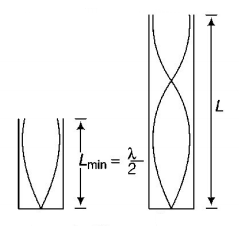Question
An air column, closed at one end and open at the other, resonates with a tunning fork when the smallest length of the column is $$50\,cm.$$ The next larger length of the column resonating with the same tunning fork is
A.
$$100\,cm$$
B.
$$150\,cm$$
C.
$$200\,cm$$
D.
$$66.7\,cm$$
Answer :
$$150\,cm$$
Solution :
The smallest length of the air column is associated with fundamental mode of vibration of the air column as shown in the diagram.

$$\because {L_{\min }} = \frac{\lambda }{4} \Rightarrow 50\,cm = \frac{\lambda }{4} \Rightarrow \lambda = 200\,cm$$
The next higher length of the air column is
$$\eqalign{ & L = \frac{\lambda }{4} + \frac{\lambda }{2} = \frac{{\lambda + 2\lambda }}{4} = \frac{{3\lambda }}{4} \cr & = \frac{3}{4} \times 200 = 150\,cm \cr} $$
The smallest length of the air column is associated with fundamental mode of vibration of the air column as shown in the diagram.

$$\because {L_{\min }} = \frac{\lambda }{4} \Rightarrow 50\,cm = \frac{\lambda }{4} \Rightarrow \lambda = 200\,cm$$
The next higher length of the air column is
$$\eqalign{ & L = \frac{\lambda }{4} + \frac{\lambda }{2} = \frac{{\lambda + 2\lambda }}{4} = \frac{{3\lambda }}{4} \cr & = \frac{3}{4} \times 200 = 150\,cm \cr} $$